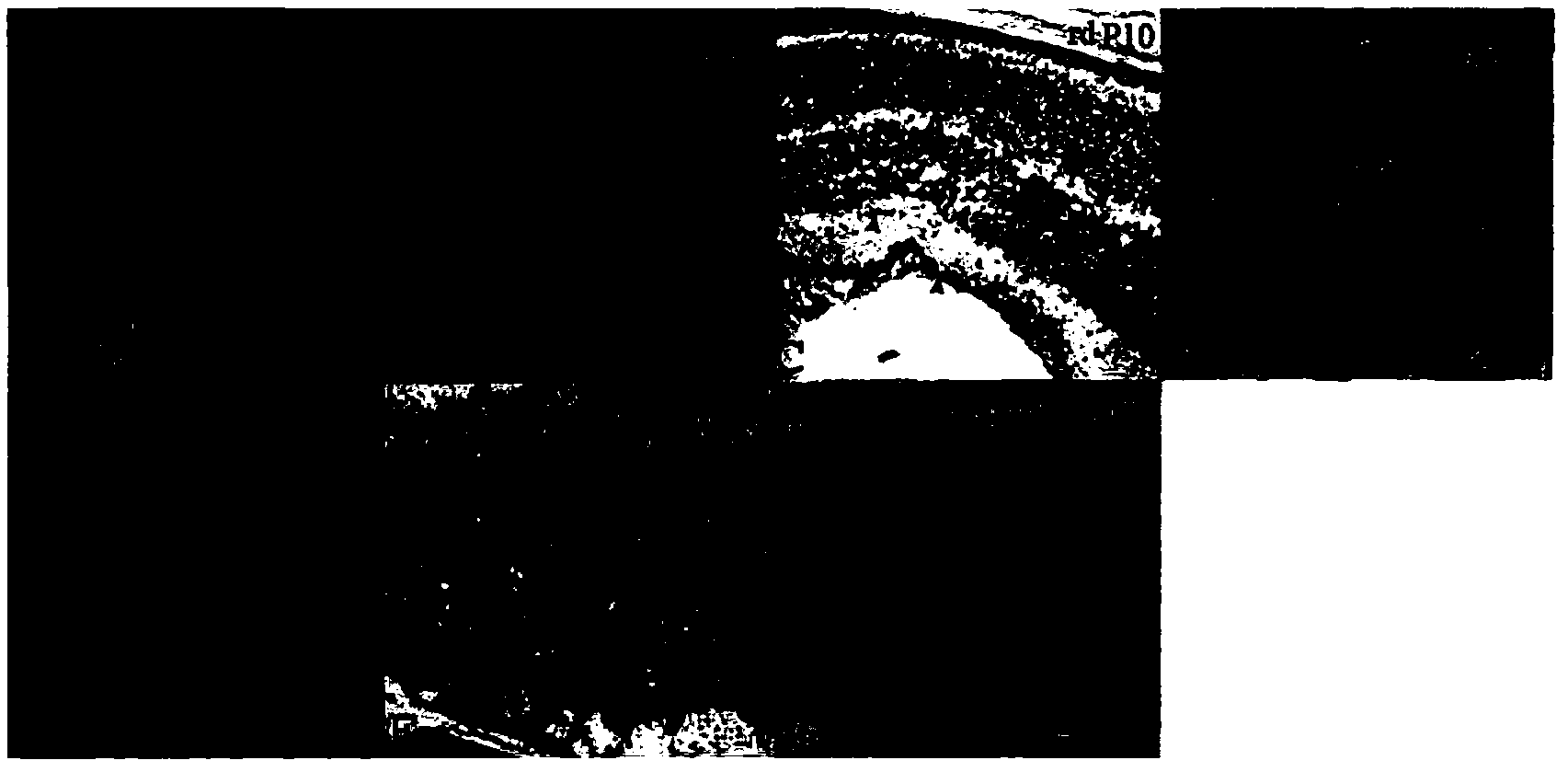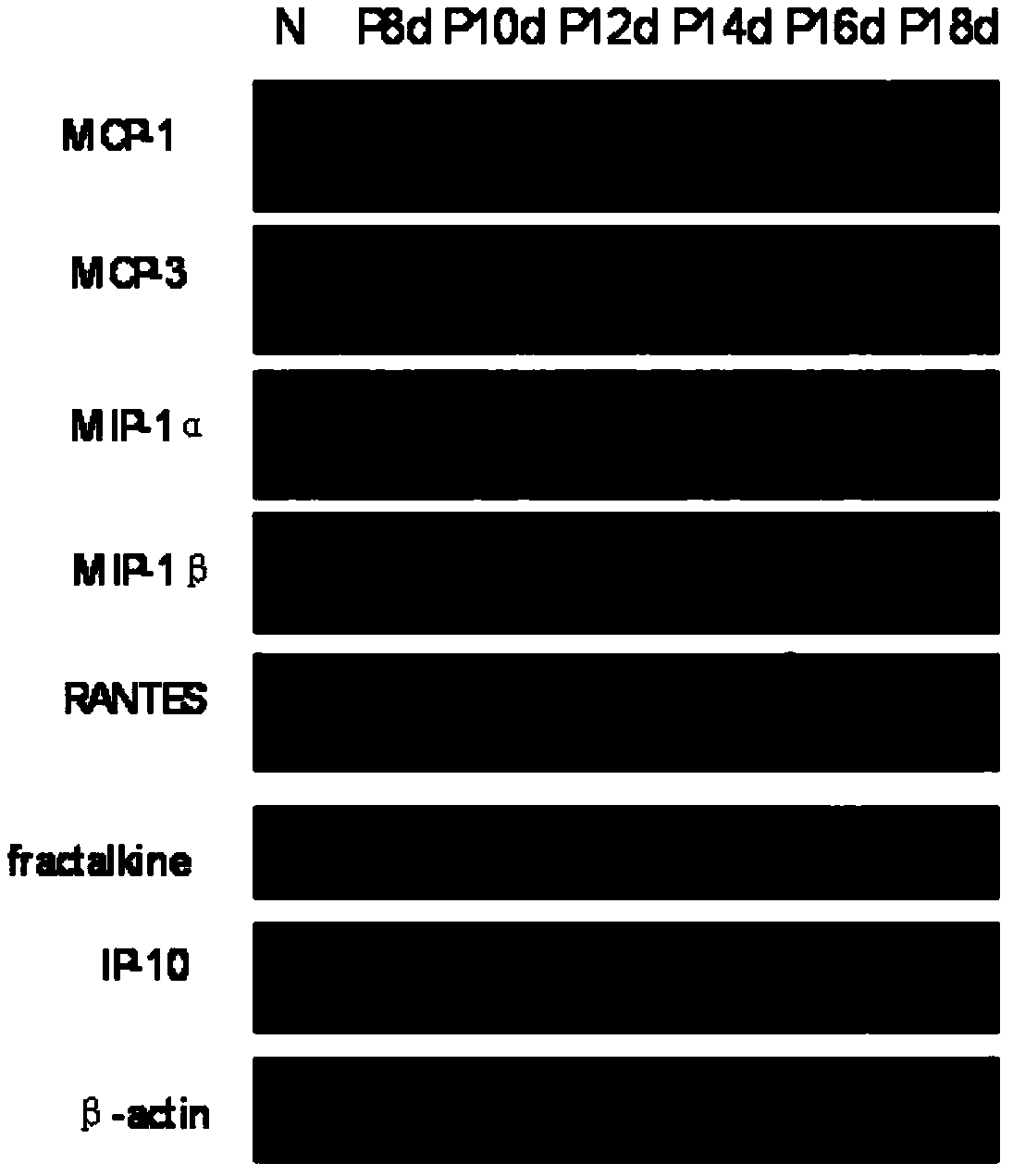Application of met-RANTES in preparing medicine used for treating inherited retinal degeneration
A genetic and drug technology, applied in drug combinations, pharmaceutical formulations, medical preparations containing active ingredients, etc., can solve the problems of unclear expression and activation mechanism, uncertain oxidative damage response, etc., to achieve strong practicability, therapeutic Early intervention, simple results
- Summary
- Abstract
- Description
- Claims
- Application Information
AI Technical Summary
Problems solved by technology
Method used
Image
Examples
Embodiment 1
[0059] Example 1 Expression and localization of β-chemokine receptor in the retina of rd mice of different ages
[0060] 1) Preparation of animal and tissue slices:
[0061] 350 male rd mice and 350 normal C57BL / 6N mice. 8 days, 10 days, 12 days, 14 days, 16 days and 18 days after birth of rd mice, 12 eyeballs of 6 rd mice were taken for detection, and the same number of mice of the same age and the same species were used as controls. After the mice were killed by neck dislocation, the eyeballs were quickly removed for tissue sections or the retinas were collected for molecular biology testing. Tissue sections were frozen and fixed in cold acetone for immunofluorescent staining.
[0062] 2) RT-PCR and immunofluorescence were used to detect the changes in the expression levels and cell localization of retinal CCR1, CCR2, CCR3 and CCR5 during the degeneration of photoreceptor cells in rd mice.
[0063] RT-PCR: The extraction of total RNA from fresh retinas of rd mice and co...
Embodiment 2
[0070] Example 2 Mechanism of Oxidative Damage in Microglia or Photoreceptor Cells after β Chemokine Receptor Activation
[0071] This example demonstrates the oxidative damage response that occurs after the activation of microglial cells or photoreceptor cell β chemokine receptors, which generate extracellular or intracellular ROS (including NO) respectively, thereby causing photoreceptor cell apoptosis.
[0072] 1. Immunohistochemistry: detection of iNOS and gp in retinal degeneration of rd mice 91phox organization expression. Frozen sections were dried naturally. 3%H 2 o 2 The solution was incubated at room temperature for 30 min to block endogenous peroxidase. Normal secondary antibody serum working solution was blocked and incubated at room temperature for 15 minutes. mouse anti-mouse gp 91phox Monoclonal antibody (1:500, Signal Transduction Laboratory) or rabbit anti-mouse iNOS (1:100, Santa Cruz Biotechnology) was incubated overnight at 4°C, and PBS was used ins...
Embodiment 3
[0095] Example 3 Study on the protection of photoreceptor cells and the therapeutic effect of met-RANTES on retinal degeneration in vivo and in vitro
[0096] 1. Study on the protection of photoreceptor cells and the therapeutic effect of met-RANTES on retinal degeneration in vivo
[0097] 1) Systemic administration
[0098] In view of the fact that document 6 confirmed that rd mice were born on the 8th day of birth as the initial period of β chemokine expression, this example selected rd mice on the 7th day after birth to compare and study the protective effect of intraperitoneal injection of met-RANTES in PBS solution on photoreceptor cells and Its therapeutic effect on retinal degeneration.
[0099] The experiment set up a control group and a treatment group, and each group consisted of 6 rd mice born on the seventh day after birth. Among them, the control group was intraperitoneally injected with 0.2ml PBS; the treatment group was intraperitoneally injected with 0.2ml ...
PUM
 Login to View More
Login to View More Abstract
Description
Claims
Application Information
 Login to View More
Login to View More - R&D
- Intellectual Property
- Life Sciences
- Materials
- Tech Scout
- Unparalleled Data Quality
- Higher Quality Content
- 60% Fewer Hallucinations
Browse by: Latest US Patents, China's latest patents, Technical Efficacy Thesaurus, Application Domain, Technology Topic, Popular Technical Reports.
© 2025 PatSnap. All rights reserved.Legal|Privacy policy|Modern Slavery Act Transparency Statement|Sitemap|About US| Contact US: help@patsnap.com



